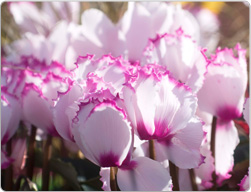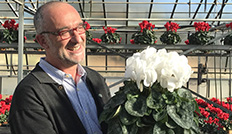 Professional area | Diseases factsheet | Fungi | Septoria cyclaminis
Professional area | Diseases factsheet | Fungi | Septoria cyclaminis
The fungus Septoria cyclaminis causes foliar blotches appearing on the underside of leaves. These attacks can be mistaken for those of Phyllosticta cyclaminis.
This is not a disease which causes major problems in the case of cyclamen. Nevertheless in mild and humid conditions it can spread very rapidly.
Septoria are fungi of the Phomaceae family, of the order Phomales in the class Adelomycetes (Deuteromycetes, or Imperfect Fungi): mycelial with septa. They have no known sexual reproduction, instead producing conidia, or spores, by budding-off from specialised mycelium filaments.
A number of species are responsible for surface blotches in a great many hosts. Septoria cyclaminis is the one that causes septoriosis in cyclamen. The disease occurs in conditions of humidity or heavy watering and mild temperatures, but does not cause great problems in the case of cyclamen.
The signs usually appear from July onwards. They are very similar to those caused by another plant disease fungus, Phyllosticta cyclaminis.
When the spore has germinated, the mycelium it produces penetrates the plant through the stomata on the underside of the leaves, and there it develops in the intercellular spaces.
Symptoms show some 10 to 16 days after the start of infection.
Yellowish-brown to reddish blotches appear on the leaf, rounded or polygonal and in the direction of the veins. There can be a fairly large number of such blotches, and they may dry up the leaf. Next, in the centre of these, there appear small raised dots or pustules, which are in fact the fruiting bodies of the fungus, from which will come the spores of the next generation of infection.
There can also be blotches on the stalk, and the tuber too can be affected, showing oily brown patches.
Mild, warm environments suit the development of this fungus.
In damp weather, the fruiting bodies produce conidia, which are spread by water, on tools and clothes, and on insects. This disease spreads very fast.
The fungus can survive, as fruiting bodies, on plant debris. Infection can take place either in the air or underground.
Under favourable conditions (sprinkler watering, water on the leaves) spores germinate in about 20 hours at 18ºC (64ºF). They do need the presence of water on the leaves for a minimum of 12 hours. If the leaves should stay wet for about 30 hours, then this will lead to a serious degree of infection.
It must be borne in mind that humidity encourages this fungus and its ideal temperature for development is between 20ºC (68ºF) and 27ºC (81ºF). When cyclamen are grown under glass, the required conditions are often present.
When watering, try to avoid splashing the lower leaves. It is better from this point of view to water the plants from beneath rather than by sprinkling.
Additionally:
- remove and burn affected leaves, as well as all plant debris.
Of the two pathogens which can cause blotches on cyclamen leaves, it is not obvious precisely which is responsible on any particular occasion; but although they do not belong to the same family, the same group of fungicides is used against both of them. Particular active ingredients must be used in rotation, so as to minimise the emergence of resistant strains.
The constant development of the regulations and homologations of phytosanitary treatment products, and the differences in regulations according to each country make it impossible for us to include updated information on homologations. Each producer will have to contact his local plant protection bureau to obtain the latest updates concerning the regulations and use of phytosanitary products. We strongly advise testing beforehand on a plant sample in order to measure the chemical’s activity (establishing the dose) and any effect on the plant (plant poisoning).
This advice sheet is based on the methods used at the SCEA at Montourey (Fréjus, France). These procedures may need some modification to adapt them to other climatic situations. Before starting to grow cyclamen there needs to be a review of precautions against pests and diseases. We must point out that our advice and suggestions are offered for information purposes and therefore cannot include any guarantee of specific results; it is a good idea to carry out trials beforehand.

2565, rue de Montourey
83600 Fréjus - France
International telephone : +33 (0)4 94 19 73 04
Switchboard : + 33 (0)4 94 19 73 00
Fax : +33 (0)4 94 19 73 19

